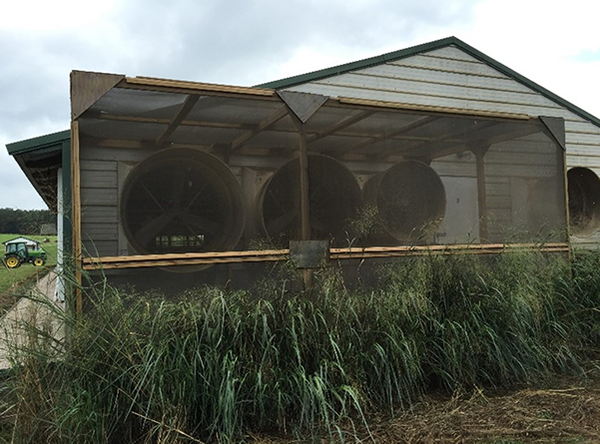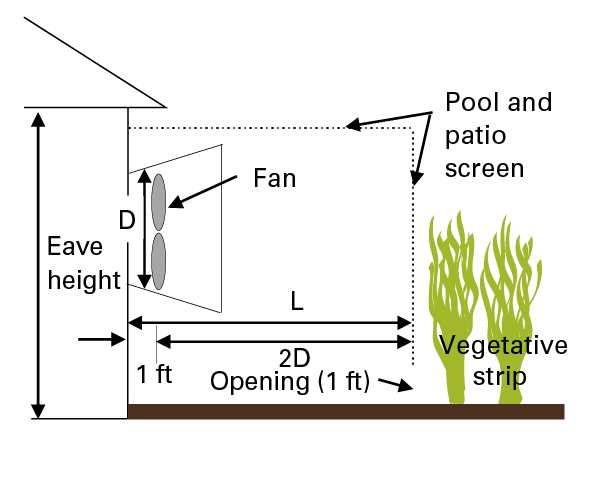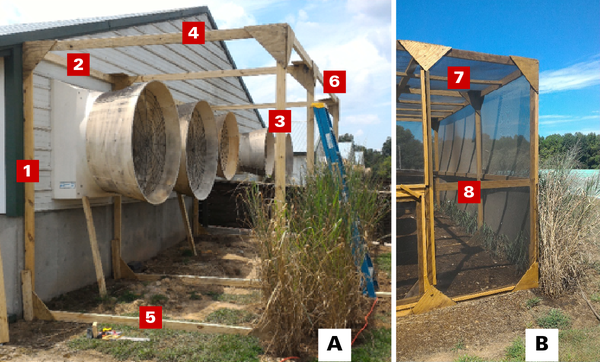Highlights
- Odor emissions from swine barns are a major challenge for the North Carolina pork industry.
- Research demonstrated that a simple pairing of a windbreak wall with a vegetative strip was a very effective system for reducing odor emissions from fan-ventilated barns.
- The system has little effect on the barn ventilation since its backpressure is very low.
- At current prices, the material cost for the system is about $1 per pig placed, and it can be readily built with farm labor and hand tools.
- The system is easily retrofittable on existing barns, highly modular, and robust.
Introduction
Air emissions, particularly odor, from swine operations are a major challenge in North Carolina (the second largest U.S. swine producer) and throughout the U.S. pork industry. The North Carolina Department of Environmental Quality’s Division of Air Quality has the authority to investigate odor complaints from swine operations, with some exceptions. Several nuisance lawsuits filed by several plaintiffs against a major swine integrator have led to $98 million in judgments (Yeomen 2020). These plaintiffs were neighbors of contract producers raising pigs for the swine integrator. Several other lawsuits are pending in North Carolina courts. Hence, there is a need for methods to reduce air emissions from swine farms. Dietary manipulation, waste amendments, indoor air quality treatment (for example, sprinkling oil), and exhaust air treatment can all be used to reduce emissions from swine farms (Maurer et al. 2016). This fact sheet provides information regarding exhaust air treatment methods compatible with existing U.S. swine barn ventilation systems, with emphasis on the engineered windbreak wall–vegetative strip system.
In addition to being affordable, an exhaust treatment system typically imposes very little backpressure on the ventilation fans, which is important because high backpressure can reduce ventilation rate through the barn and adversely impact swine welfare and performance. Two exhaust treatment systems that can be used to reduce emissions from swine barns include the vegetative environmental belts (VEBs) or shelterbelts and the electrostatic particle ionization (EPI) Air Filter Wall. A VEB consists of suitable shrubs and trees planted downwind of the exhaust fans. The VEB dilutes and disperses the pollutant plume; traps and helps settle out odorous dust; absorbs or adsorbs odorous gases; and improves the aesthetics (Tyndall and Colletti 2007). Emissions of ammonia and dust are reduced by almost 50%, while odor emissions are reduced by up to 15% by VEBs (Tyndall and Colletti 2007). However, VEBs take as long as five years to be effective, require large footprints, and require regular maintenance (Tyndall and Colletti 2007).
The EPI Air Filter Wall developed by Baumgartner Environics Inc. of Olivia, Minnesota, consists of a low-porosity geotextile fabric screen placed about 8 feet in front of the exhaust fans. The exhaust air is ionized by an electrostatic precipitator that causes dust (and attached gases) to attach to grounded surfaces or clump together to form larger particles that settle out; the “cleaned” air exits from the space between the fans and screen (Mettler 2019). Andersen (2019) reported that the EPI Air Filter Wall reduced odor and dust emissions by 30% and 50%, respectively, from a swine barn. While no backpressure data are available for the VEBs or the EPI Air Filter Wall, unlike industrial exhaust treatment systems, they are likely to impose very little backpressure.
Ajami et al. (2019) evaluated an engineered windbreak wall–vegetative filter strip system (Figure 1), henceforth referred to as “system.” The system consisted of a wood-framed structure covered by a fiberglass pool-and-patio screen covering the exhaust fans. The screen (mesh size 18×14; porosity 60%) is widely available in hardware stores. Based on computer modeling, finer screens were not considered because they increased backpressure on the fans, which would be further worsened by dust clogging. Also based on computer modeling, to prevent backpressure from increasing due to screen clogging in the absence of rain, a 12-inch opening was created at the bottom of the front screen. An 18-inch-wide strip of switchgrass was planted to cover the 12-inch opening (Ajami et al. 2019). Belt (2015) recommended the use of switchgrass in VEBs. The system reduced swine barn odor emission at 33 feet from the fans by 71% and dust emission by 28% (Ajami et al. 2019). Of significance was its effect on the house ventilation system, which was very small; backpressure on the house fans was less than 0.02 inches of water column with all three fans running (Ajami et al. 2019).
Based on June 2020 North Carolina prices, the material cost of the system (including switchgrass plugs) that treats all of the exhaust (about 80,000 cfm) from a finishing barn (880 pigs) is about $900, or $1 per pig placed, including state taxes. The system was very robust and incurred little damage during Hurricane Florence, which produced peak wind gusts of 40 mph and heavy rainfall. As we will discuss later, the system has a modest footprint, so retrofitting existing barns with such a system is not difficult. In addition, this system is very modular and can be scaled up or down readily depending on the number of fans to be covered. This system is ideal for a tunnel-ventilated barn where several fans are clustered together, but it can also be used on sidewall-ventilated barns. Since this system is used to treat emissions from the exhaust fans, it does not affect air quality inside the barns.
How the System Functions
The system reduces emissions, particularly odors, by trapping some of the dust on the screen as well as on the ground. Since dust transports odorous gases, reducing dust emissions reduces odor emissions (Hammond et al. 1981). As the front screen gets clogged with dust, more of the exhaust leaves through the top and side screens, causing dilution. The plants (switchgrass) also trap some dust and absorb nitrogen in the dust through the roots. They also absorb some odorous gases directly through the leaves (Morgan and Parton 1989; Hiatt 1998) and transport a fraction of those gases into the root zone, where the gases are degraded by soil microbes (Dela Cruz et al. 2014).
The system’s performance will vary depending on the number of fans operating at any time in the system, dust accumulation on the screen, and the height and denseness of vegetation. When the plants become dormant in fall, the system is less effective. The 71% odor reduction measured in summer and fall of 2018 (Ajami et al. 2019) occurred with no vegetation in front of the minimum ventilation fan (small fan on the right shown in Figure 1), and vegetation in front of the other fans was under 2 feet tall. The system shown in Figure 1 is from summer of 2017, when the vegetation was taller than when the odor measurements were made. In summer of 2018, the switchgrass had to be replanted, as excess pruning in the spring killed the earlier planting. With taller vegetation (5 to 6 feet), odor and dust might have been further reduced.
System Construction and Maintenance
A box-shaped structure made of pressure-treated wood and pool-and-patio screen (mesh size 18 × 14; porosity 60%) identical to the one used by Ajami et al. (2019) is proposed. Placing the front screen at least twice the fan diameter from the fan blade keeps backpressure inside the system acceptably low (Ajami et al. 2019). For example, using the equations provided in Figure 2, to treat exhaust from 4-foot (48-inch) fans, the system length (L), plus the distance from the barn wall to the fan blades, should be 9 feet (2 times 4 feet plus 1 foot). If there are different sizes of fans (for example, 48-inch and 36-inch fans), the largest fan diameter (D) should be used to calculate L. When space is not limited, L can be increased to 2.5 times D plus 1 foot. System backpressure will decrease as L is increased. The height of the system can be close to the barn eave height, and it should be wide enough to cover all the fans in the fan bank. The opening at the bottom of the front screen is to prevent excessive backpressure and should be at least 1 foot high (Figure 2).
Producers have experience in building wood structures. Here we provide broad guidelines on building the system, with the caveat that barns can widely vary in design. Southern yellow pine grade #2 or lumber species and grade of comparable load-carrying capacity should be used. All lumber sizes mentioned are nominal sizes, and only pressure-treated lumber should be used; wood screws compatible with treated lumber should be used. In addition to the wind load, the system must support the worker doing repair and maintenance on the top. Two side views of the system tested by Ajami et al. (2019) while under construction and upon completion are shown in Figure 3. Size and spacing recommendations for the various system components labeled in Figure 3 are discussed below with slight modifications to make the system safe and sturdy, especially during construction and repairs.
Member 1: This member ties the structure to the barn. Attach the 2-inch x 4-inch vertical member to the stud in the barn wall. Member 1 can be kept above the soil but must be attached to the concrete wall using suitable fasteners. These members should be spaced no more than 9 feet apart, so for fans bigger than 48 inches, install a member between each fan.
Member 2: This horizontal 2-inch x 4-inch member is required to create the structure for the top screen.
Member 3: This member anchors the structure. Bury these 4-inch x 4-inch vertical posts 3 feet in the soil. Member 3 has to be paired with member 1.
Member 4: This 2-inch x 4-inch lumber-on-edge (for greater load-carrying capacity) member connects member 2 to member 3 to support the top screen.
Member 5: This 2-inch x 4-inch on-edge member connects member 1 to member 3 to make the system sturdy. One member 5 is needed for each member 1 (or member 3).
Member 6: This 2-inch x 4-inch lumber on edge runs parallel to member 2 and ties together the 4-inch x 4-inch posts (member 3) for greater structural rigidity.
Member 7: These members are required to create a safe scaffold for the worker doing repairs on the top. Several of these braces (2-inch x 4-inch lumber on edge) are laid parallel to member 4 at spacing not exceeding 2 feet, connecting member 2 to member 6. Connect adjacent braces to one another using 2-inch x 4-inch lumber pieces. While Ajami et al. (2019) did not experience heavy snowfall, spacing the members 2 feet apart and bracing them could be adequate for eastern North Carolina, where much swine production is concentrated. In areas with higher snowfall, some design changes may be required.
Member 8: These are 2-inch x 4-inch lumber braces that support the front and side screens and are installed about mid-height.
For durability, the construction described previously is heavier than the system constructed by Ajami et al. (2019) using 2-inch x 4-inch treated dimension lumber because their system was built for a short-term research project. However, as of June 2020, the system had been operating four years without requiring any structural repairs. You should strengthen the connections with suitable hanger, brackets, ½-inch plywood gussets (Figure 3), or lumber. Staple the fiberglass screen to the lumber frame and secure it properly using furring strips (Figure 3) or strapping strips to secure tri-ply fabric sheets to lumber (in chicken houses). A screen door may be provided, as was done by Ajami et al. (2019). Based on site conditions, you may have to modify the design and construction. For example, if feedlines enter the house through the endwalls where the fans are located, you should omit the top screen. Omitting the top screen will reduce the effectiveness of the system, but it will considerably reduce cost and complexity. As is clear from the previous description, the system can be built very rapidly with farm labor using hand tools.
Plant switchgrass to screen the opening at the bottom of the front screen (Figure 2) in an 18-inch-wide strip in spring when the soil temperature is above 60°F, preferably late March through April. Ajami et al. (2019) reported that the switchgrass cultivar ‘Alamo’ grew more vigorously and taller than ‘Shenandoah’ at their research site, which was in Zone 8a of the U.S. Department of Agriculture Plant Hardiness Zone Map. Select the switchgrass cultivar based on your location and plant availability at local nurseries. Till the soil to facilitate rapid root development. Plant at least two parallel rows with plants in a row spaced 12 inches apart. Stagger the plants in the two rows with respect to one another to prevent short-circuiting.
The system requires very little maintenance since it is readily cleaned by rain. If it does not rain for more than three weeks and the screen is clogged, wash off the screen with a garden hose nozzle. Since it is porous, it can resist high wind speeds, as was observed by Ajami et al. (2019). In late winter, trim the dried switchgrass stubble no shorter than 6 inches or wait until spring when the plant is breaking dormancy.
References
Ajami, A., S.B. Shah, L. Wang-Li, P. Kolar, and M.S. Castillo. 2019. “Windbreak Wall-Vegetative Strip System to Reduce Air Emissions from Mechanically Ventilated Livestock Barns: Part 2—Swine House Evaluation.” Water, Air, & Soil Pollution 230, no. 12.
Andersen, D. 2019. Odor Control Options: Electrostatic Fence. Video.
Belt, S.V. 2015. Plants Tolerant of Poultry Farm Emissions in the Chesapeake Bay Watershed. Beltsville, MD: USDA-NRCS Norman A. Berg National Plant Materials Center.
Dela Cruz, M., J.H. Christensen, J.D. Thomsen, and R. Muller. 2014. “Can Ornamental Potted Plants Remove Volatile Organic Compounds from Indoor Air? A Review.” Environmental Science & Pollution Research 21, no. 24: 13909–13928.
Hammond, E.G., C. Fedler, and R.J. Smith. 1981. “Analysis of Particle-Borne Swine House Odors.” Agriculture and Environment 6, no. 4: 395–401.
Hiatt, M.H. 1998. “Bioconcentration Factors for Volatile Organic Compounds in Vegetation.” Analytical Chemistry 70, no. 5: 851–856.
Maurer, D.L., J.A. Koziel, J.D. Harmon, S.J. Hoff, A.M. Rieck-Hinz, and D.S. Andersen. 2016. “Summary of Performance Data for Technologies to Control Gaseous, Odor, and Particulate Emissions from Livestock Operations: Air Management Practices Assessment Tool (AMPAT).” Data in Brief 7: 1413–1429.
Mettler, D. 2019. “Shocking Smell: A Two-Part System for the Barn that Cleans the Air.” Manure Manager (November–December): 24–26.
Morgan, J.A. and W.J. Parton. 1989. “Characteristics of Ammonia Volatilization from Spring Wheat.” Crop Science 29, no. 3: 726.
Tyndall, J. and J. Colletti. 2007. “Mitigating Swine Odor with Strategically Designed Shelterbelt Systems: A Review.” Agroforestry Systems 69, no. 1: 45–65.
Yeomen, B. 2020. “‘Nobody wants another Flint, Michigan,’ judge tells Smithfield in hog-case appeal hearing.” Food & Environment Reporting. Jan. 31. Network.
Publication date: March 2, 2021
AG-888
N.C. Cooperative Extension prohibits discrimination and harassment regardless of age, color, disability, family and marital status, gender identity, national origin, political beliefs, race, religion, sex (including pregnancy), sexual orientation and veteran status.



